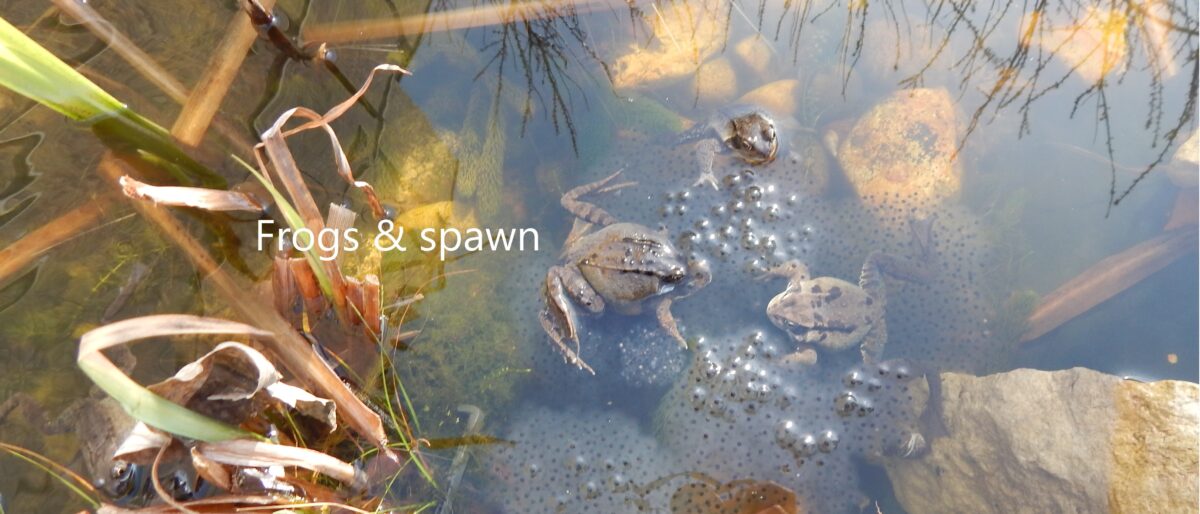In the garden yesterday, there were at least six frogs in the pond, and two more on the concrete outside the pond, hearing the croaking above them in the pond, but not knowing how to get to it. We have what we call a frog ladder, a ribbed piece of wood, slanting from ground to pond rim, but I have never seen a frog use it. Though, they must, or how else could they get up to the pond, the sides about half a metre above ground level. It is likely the females have even more difficulty, being hampered with the weight of eggs.
Today, there are around eight frogs in the pond. None female. The males croak to attract females. Yesterday, I heard them croaking, but not today.
I do a very rough calculation on how many eggs are in the spawn we have:
There’s about a litre of spawn, 1000 cc
Each egg is separated from the others by around 0.5 cm.
Allowing a cube of 0.5 x 0.5 x 0.5 per egg = 0.125 cc
1000 cc ÷ 0.125 = 8000 eggs
The number surprises me. But a female can lay 4000 eggs. So just two females could lay that many. I know from past years that there will black clouds of tadpoles eating the remnant of jelly, and within a week or so, having eaten it all they will be all over the pond.
Of course, we may get more spawn, but assuming that is it, how many of these eggs will become mature adults. There are a number of stages:
1. Three weeks to hatch, though could be less if it stays warm. Most will will hatch. There always some that don’t. Probably unfertilised eggs. Say 80% hatch, that’s around 6000 tadpoles.
2. Over three months, they develop into froglets (tiny, immature frogs). There’s predation and disease to lessen the number. I don’t how many develop into froglets as it is impossible to count them.
3. The froglets leave the pond, and over two to three years develop into mature adults. Predation from birds and cats hits them hard. A dry summer will cull the numbers further.
2. During March of each year, 20 to 30 adult frogs return to the pond to breed. But common frogs live 5 to 10 years. So they may well come to the pond to breed several times in their lifetime.
Let’s try some figures, with a lot of guesswork.
8000 eggs à 6000 tadpoles à 500 froglets à 10 adults
So 1 in 600 tadpoles make it to adulthood in this rough and ready estimate.
A simpler way to estimate is to go with the thought, that to keep the species going, all that we need from each female’s spawn is one female and one male. That would be an average across the country, but some places will beat the average and others will be less.
8000 eggs à 6000 tadpoles à 4 adults
That assumes the 8000 eggs were laid by 2 females. In this estimate 1 tadpole in 1500 make it to adulthood.
My two estimates give me 1 tadpole in 600 surviving to adulthood, and 1 in 1500. I’ve looked for research on this but haven’t found any. You could take a mid figure, say 1 in a 1000. Not satisfactory estimates, but we do know there is an awful cull along the way from tadpoles to adults.
Laying lots of eggs is a survival technique for the common frog. Human beings maintain their numbers with few children but with lots of parental care and protection. The common frog gives no care to its offspring. Once hatched, they are on their own with plenty of predators out to get a tasty tadpole. So lots of eggs is a necessity to maintain the species, in the hope that out of the many a few will go on to breed.
From examples such as this, Charles Darwin developed his ideas on evolution by natural selection. In essence, it is pretty simple. If a breeding pair lays more eggs that others, it will have more offspring surviving who will have the genes for more offspring. And so forth, increasing though the generations. We have got to the point where a female common frog can lay up to 4000 eggs. Quite a number. It strikes me as awfully wasteful strategy, cruel even, as most will die before adulthood. But nature is not sentimental.

